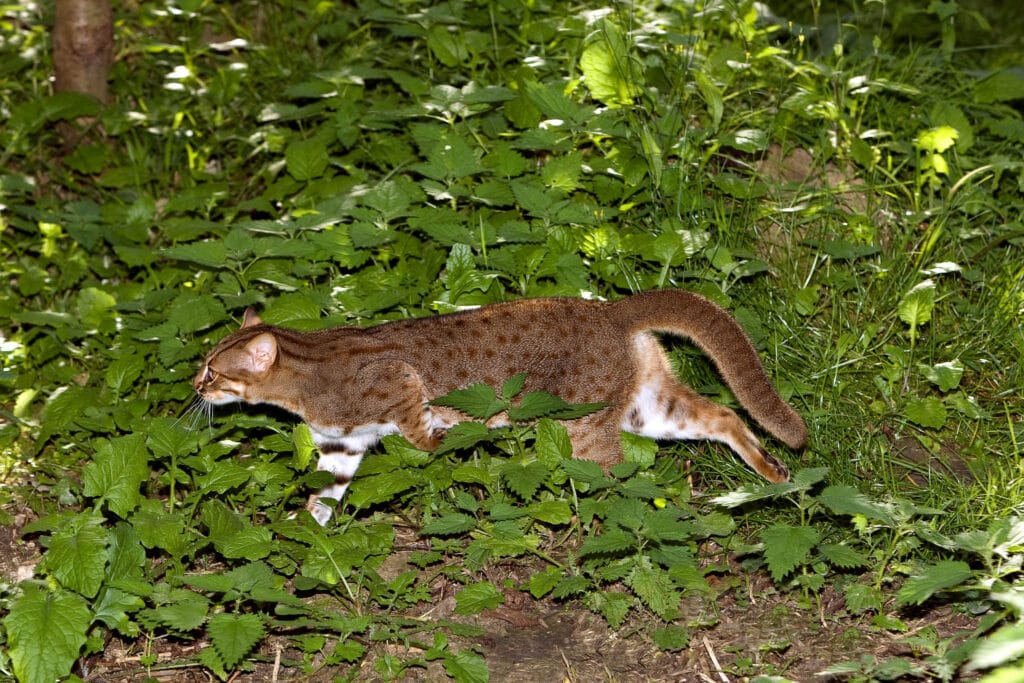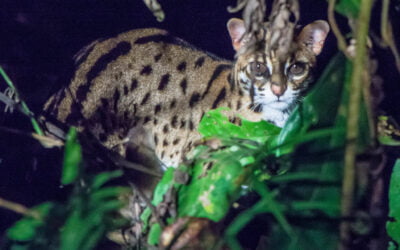Physical description of Rusty-spotted Cats
Guess what? The rusty-spotted cat isn’t rusty colored. It is more of a grey (and in some areas, yes it is more reddish brown), but it is spotted, and it is these spots that are generally a rusty brown color. So it isn’t a rusty spotted-cat but a rusty-spotted cat. Hyphenation is important to cats. There is also some striping on the shoulders and head, somewhat darker than the spots.
This is the smallest of the cats, only about 1.5 kg in weight. Males are a little heavier, females a little smaller. Domestic cats are about twice the size. The tail is also relatively short, only about half the total body length.
Rusty-spotted Cat: Habitat and Distribution
Rusty-spotted cats are found in South Asia, mostly in India and Sri Lanka. They range from the North of India, near Nepal, through central India to the rainforests of the Western Ghats. They live in the dry and tropical forests of India and are pretty much everywhere except the desert northwest and the mountainous north.
The rusty-spotted cat’s habitat is generally drier forest, but this is not its exclusive habitat anymore. The cat is now known to live in human habitats as well, mostly in farmland and agricultural land, though it is more often found in the drier forests. While forest cover might be a defining characteristic of their habitat, given that they live in both tropical and drier deciduous forest, the rusty-spotted cat also has been found in less forested areas.
Rusty-spotted Cat behavior
Like almost all other cat species, independence brings solitary living. Given that the range of the male is a bit larger, it probably overlaps that of nearby females, but they haven’t been regularly sighted together except during mating periods. However, mother and kittens do stay together. Rusty-spotted cats are active all the time but probably more so during the nighttime. Most sightings occur during dawn and dusk.
Scent and spray marking. Not much else is known.
What do Rusty-spotted Cats eat?
Reliable evidence on the complete diet is hard to come by. It is observed that some rusty-spotted cats eat birds and mammals, small ones, as it is a small cat. It is possible that they are not strict carnivores like most cats. Research in zoos has shown that they eat fruits, but that does not guarantee they do the same in the wild.

Mating and Parental care of Rusty-spotted Cats
Given a lack of clear information, we have to assume that the rusty-spotted cat reproduces in the same ways as similar species in the Prionailurs genus, such as the leopard cat.
The idea that they are similar hasn’t been disproven, though the amount of research on the rusty-spotted cat in the wild is limited. Some things were observed in zoos, but that doesn’t mean that everything we were able to learn applies in the wild as well.
It is possible that the cats are polygynous, meaning that the male has territories that overlap that of females and mates with multiple. This would be in line with the similar leopard cats from the same family, Prionailurus.
Gestation lasts for a bit more than two months, and kittens are born in some sort of den, like hollow trees or similarly protected areas. In five to six weeks the kittens are weaned and are ready for the world. They are very active from about four weeks on. Like all cats, weaning isn’t instant independence. There is a lot of time devoted to learning to hunt by copying the mother. True independence probably comes around nine months.
Rusty-spotted Cats and their ecosystem
They probably control their prey species. They might prey on a specific small mammal more often and prevent it from getting out of control. We cannot be sure. They could also be of no use to the ecosystem, but experience tells us otherwise. Every little link is vital.
Conservation status and human impact on Rusty-spotted Cats
Habitat loss is the main problem facing rusty-spotted cats, leading to a reduced population. At the moment, the IUCN red list status is near threatened. This could change as the population declines. Increasing agriculture is the leading cause of habitat loss.
Other important information about Rusty-spotted Cats
Prionailurus rubiginosus phillipsi is the Sri Lankan subspecies.










